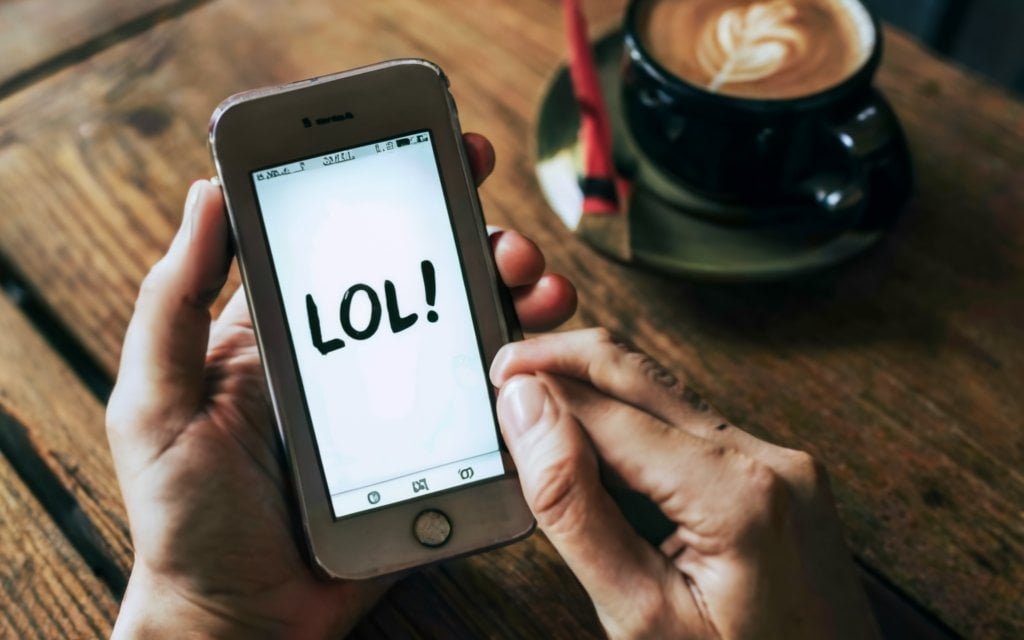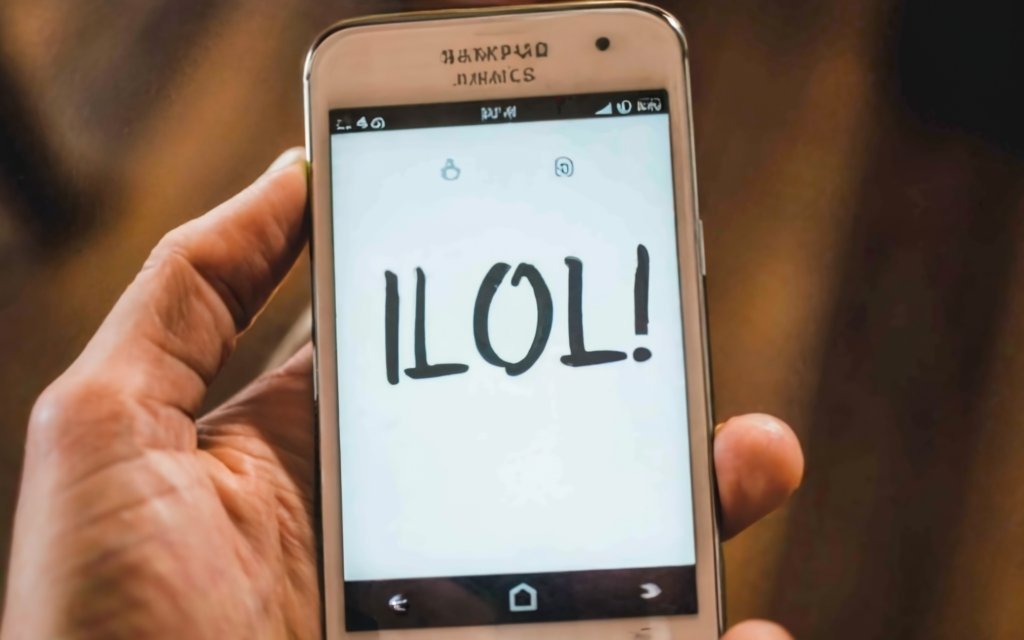In texting, LOL most commonly stands for “laughing out loud”. It’s used to express amusement or laughter in response to something funny.
Here are some additional things to know about LOL:
- Pronunciation: While you might see it written as “el oh el” sometimes, most people just say “lol” out loud.
- Intensity: The intensity of laughter can be conveyed through capitalization. “lol” is a mild chuckle, while “LOL” or “LOOOOL” might indicate a more intense outburst.
- Beyond laughter: While traditionally used for humor, LOL can also be used to acknowledge something awkward or strange, sometimes sarcastically.
- Context matters: If you’re unsure how LOL is meant in a specific context, it’s generally best to interpret it literally as laughter unless your intuition tells you otherwise.
Overall, LOL is a versatile way to add levity and informality to text communication. Just remember to use it judiciously and be mindful of its potential interpretations. You should read another article I wrote about >>>> How to Block a Number From Texting to learn more about texting and messaging.
LOL Decoded: Unveiling the Secrets of Textual Laughter.
Ah, LOL. Three little letters that have dominated the digital landscape for decades, igniting countless guffaws and sparking endless debates. But have you ever stopped to consider the true depths of LOL’s meaning? Its history, its nuances, its very soul? Buckle up, text-savvy friends, because we’re about to embark on a linguistic safari to uncover the secrets of this ubiquitous acronym.
Part 1: The Origins of Laughter – From Bards to Bytes.
Remember the days of dial-up modems and BBS boards? Yeah, I do too. Back then, LOL wasn’t the mainstream behemoth it is today. It was a humble acronym birthed in the early 90s, whispered amongst techie tribes as a shorthand for… well, you guessed it, “laughing out loud.” It was raw, honest amusement, devoid of emojis and GIFs, born in the golden age of ASCII art and MUDs.
But LOL wasn’t always about guffaws, oh no. In its early days, it moonlighted as a cryptic carrier of other meanings. “Lots of luck,” “lots of love,” and even “little old lady” graced its pixelated form. But as the internet transformed, so did LOL’s purpose. Social media and texting became the new frontiers, and LOL, with its infectious brevity and universal appeal, claimed its rightful throne as the digital king of laughter.
Part 2: LOL in Action – More Than Meets the Eye.
Sure, LOL might seem straightforward. You see it, you chuckle, you move on. But trust me, there’s more to this acronym than meets the eye. It’s a master of disguise, capable of expressing a kaleidoscope of emotions within its three tiny letters.
Take intensity, for example. A simple “lol” is a polite snort, a barely-there acknowledgment of amusement. But ramp it up to “LOL” or, dare I say, “LOOOOL,” and you’re suddenly rolling on the metaphorical floor, tears streaming down your virtual cheeks.

Context, oh context, you glorious chameleon! Just throw in a sarcastic remark or a cringe-worthy emoji alongside LOL, and its entire meaning flips like a well-timed pancake. It can ease awkwardness, soften criticism, or even add a playful layer to heartfelt confessions.
And let’s not forget LOL’s ever-evolving family. Its cousins, LMAO (Laughing My Ass Off) and ROFL (Rolling On the Floor Laughing), bring their own distinct flavors to the party. LMAO packs a punch, a full-body guffaw that practically echoes through the screen. ROFL, on the other hand, paints a vivid picture of physical hilarity, conjuring up images of flailing limbs and snorting laughter.
Table 1: The LOL Spectrum – Shades of Meaning
| LOL Intensity | Interpretation | Tone | Example |
|---|---|---|---|
| lol | Polite chuckle | Mild amusement | “lol, that typo” |
| LOL | Hearty laugh | Genuine humor | “OMG, did you see that cat video? LOL!” |
| LOLLOL | Uncontrollable laughter | Extreme hilarity | “I can’t breathe, this meme is LOLLOL!” |
| LOL + Sarcasm | Mock amusement | Playful teasing | “LOL, yeah, right…” |
| LOL + Emoji ♀️ | Acknowledging awkwardness | Diffusing tension | “LOL, my bad, didn’t mean to send that!” |
Remember, friends, LOL is a living, breathing language. It bends, it adapts, it surprises. So next time you encounter this enigmatic acronym, take a moment to appreciate its depth. Listen to the subtle nuances, the context whispers the emotional subtext. And who knows, you might just unlock the true magic of LOL – the language of laughter in a digital world.
Part 3: The Evolving Language of LOL – Keeping Up with the Giggles.
Ah, the language of LOL is no static beast, frozen in time like a dial-up modem in amber. No, LOL dances with the digital winds, constantly evolving alongside its brethren: emojis, GIFs, and the ever-shifting tides of online trends. This is where things get truly fascinating, my fellow text enthusiasts!
Evolving LOL:
- The LOL Family Grows: Remember those cousins we met earlier, LMAO and ROFL? Well, the family tree keeps expanding! These expressive faces, called “emojis,” have become LOL’s closest rivals, each offering a nuanced flavor of mirth. leans towards pure joy, and emphasizes uncontrollable chuckles, while conveying a cheeky, “get it?” kind of amusement. The point? LOL, once the undisputed king of laughter, needs to share the throne.
- GIFs Join the Party: Moving pictures, they say, are worth a thousand LOLs. Enter the mighty GIF, the animated king of online humor. A perfectly looped meme, a perfectly timed cat fail, a perfectly synchronized dance sequence – any of these can elicit an eruption of “OMG, ROFLMAO!” that puts even the most potent LOL to shame. But hey, competition breeds variety, right? It keeps us on our toes, texting fingers twitching with the potential for hilarity.
- LOL Goes Niche: Not everyone speaks fluent LOL, believe it or not. Different communities, fandoms, and subcultures have developed their own in-jokes, their own LOL variations. “Yeet” might make a programmer snort, while “oof” resonates with gamers. It’s a beautiful, chaotic kaleidoscope of laughter, a testament to the power of language to adapt and evolve.
Table 2: LOL’s New Playground – The Rise of Visuals
| Visual Form | LOL Equivalent | Tone | Example |
|---|---|---|---|
| Hearty, lighthearted laugh | Joyful | ” That meme is too accurate!” | |
| Uncontrollable, side-splitting laughter | Over-the-top hilarity | ” I can’t stop laughing at this dog video!” | |
| Cheeky, playful amusement | Teasing, lighthearted | ” You got me there!” | |
| Cat GIF | LOL + Playful surprise | Unexpected silliness | “OMG, did you see that cat jump into the fish tank? ROFLMAO!” |
| Meme | LOL + Shared cultural reference | Insider humor | “Yeet! Nailed that presentation.” (Among programmers) |
Future of LOL:
So, where does this leave our beloved LOL, standing amidst the emoji army and the GIF battalion? Will it fade into the digital sunset, a relic of a bygone era? Not so fast, text-savvy friends! LOL has proven its adaptability, its resilience. It might morph, it might blend, it might even take on a new form entirely. But as long as humans find humor in the digital world, LOL, in some form or another, will be there to express it.
Part 4: LOL for Life – A Few Words of Wisdom.
Now, before you go forth and spam “LOL” in every text, ponder these nuggets of wisdom from your friendly neighborhood texting expert:
- Context is Queen: Remember, LOL is a chameleon. Use it wisely, considering the tone, relationship, and situation. A misplaced LOL can be as awkward as a clown at a funeral.
- Variety is the Spice of Laughter: Don’t be a one-trick pony! Spice up your repertoire with emojis, GIFs, and even the occasional well-placed “ha!” or “hee hee.” Laughter is a symphony, not a monotone drone.
- Know Your Audience: Not everyone speaks fluent LOL. Tailor your digital humor to your recipient, lest you unleash a barrage upon someone who prefers a simple “hehe.”
- Laughter is Contagious: Use LOL responsibly. A well-timed guffaw can brighten someone’s day, while overused, forced laughter can ring as hollow as a broken cymbal.
So, my dear friends, go forth and conquer the digital kingdom of laughter! Let LOL be your guide, but remember, true humor lies in connection, in shared understanding, in the joy of making someone else snort milk out their nose (figuratively, of course). Until next time, happy LOLing!
Part 5: The Psychology of LOL – When Laughter Gets Digital.
Laughter, that glorious eruption of joy, isn’t just a physical act. It’s a psychological symphony, a complex dance of emotions and neurons. And in the digital realm, where LOL reigns supreme, this dance takes on a unique twist. Let’s dive into the fascinating world of laughter psychology and see how LOL plays its part:
- Instant Gratification, Instant Laughs: Forget punchlines and setups. LOL thrives on immediacy. A funny meme, a witty tweet, a perfectly timed emoji-laced quip – these deliver instant dopamine hits, rewarding us with bursts of laughter without the delay of traditional humor. It’s the digital equivalent of a tickle attack, quick and addictive.
- Social Bonding Through Shared LOLs: Laughter isn’t just a solo act. It’s a social glue, a way to connect and build bonds. And in the digital world, LOL facilitates this like nothing else. A shared LOL in a group chat sparks conversations, strengthens friendships, and creates a sense of belonging. It’s like a high-five across the internet, a virtual nudge that says, “Hey, we get each other’s humor!”
- The Dark Side of LOL: But hold on, friends, laughter isn’t always sunshine and rainbows. Too much LOL can mask insecurity, deflect from difficult emotions, or even create pressure to perform online. The constant quest for the perfect LOL comment, and the fear of missing out on the online joke, can lead to anxiety and social comparison. Remember, LOL should be a tool for connection, not a pressure cooker.
Table 3: The Two Sides of LOL’s Coin
| Positive Effects | Negative Effects |
|---|---|
| Instantaneous laughter and joy | Overreliance on digital validation |
| Social bonding and connection | Pressure to perform and be funny |
| Shared humor and understanding | Fear of missing out and social comparison |
Part 6: The Future of LOL – Will Laughter Survive the Algorithm?
As the digital landscape evolves, so too does our relationship with LOL. Artificial intelligence, algorithms, and even personalized humor bots are creeping into our online interactions. So, what does the future hold for our beloved acronym? Will it be swallowed by the algorithms, replaced by robotic chuckles and canned laughter?
I believe LOL, in its essence, will endure. While technology might change the delivery, the human need for laughter, for connection, for shared amusement, will always remain. We might see LOL morph into new forms, integrate with AI-powered humor, or even become a relic of a bygone era.
But as long as there are humans telling jokes, sharing funny cat videos, and finding absurdity in the digital world, there will always be a place for the spirit of LOL, the unbridled joy of laughter, to shine through.

Remember, friends, laughter is the universal language. Use it wisely, use it generously, and use it to bridge the digital divide. LOL responsibly, laugh heartily, and never underestimate the power of a well-placed (and well-timed) “LOL.” Now go forth and spread the digital joy!
Bonus Section: Consider adding a brief exploration of LOL in different cultures, how humor and online communication vary across the globe. Perhaps highlight some interesting examples of cultural LOL-equivalents or funny misinterpretations across digital borders.







